
Skunks are notorious for their unpleasant odor, and encountering one can be a smelly and unpleasant experience. If you are having a skunk problem on your property, it’s important to know how to trap them safely and effectively. This article will provide tips and tricks for trapping a skunk without getting sprayed.
First and foremost, it’s important to understand that skunks are wild animals and must be treated cautiously. Trapping a skunk without the proper knowledge and equipment can be dangerous for both you and the animal. It’s best to consult a professional wildlife removal service before trying live skunk trapping alone.
If you feel confident in your ability to trap a skunk safely, you should follow a few key steps. From choosing the right trap to baiting it effectively, we’ll cover everything you need to know to trap a skunk and prevent future encounters successfully.
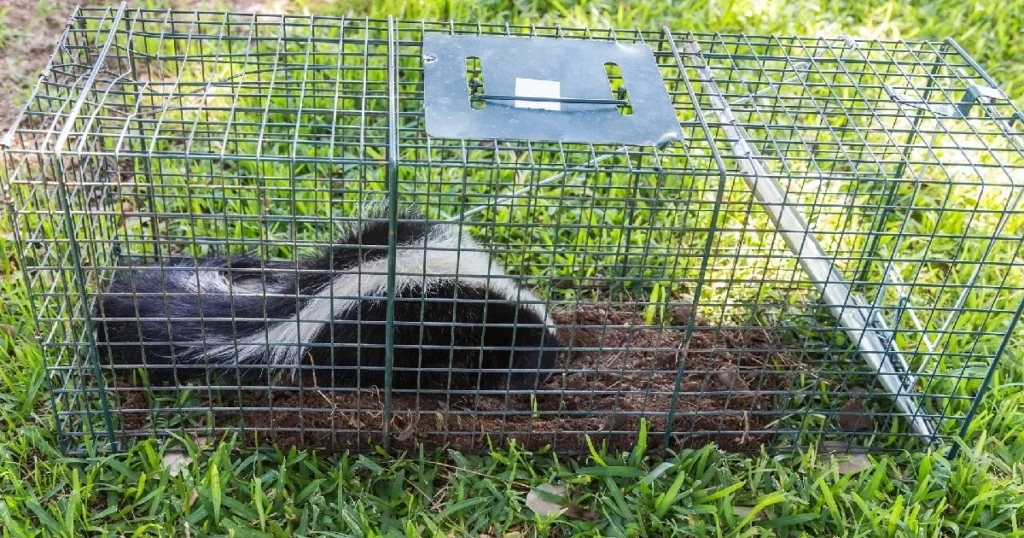
Skunks are nocturnal animals that prefer to live in wooded areas, fields, and brushy habitats. They are known for their distinctive black and white striped fur, which serves as a warning to predators. Skunks have poor eyesight but an excellent sense of smell, which they use constantly to locate food and potential mates. They are solitary creatures, choosing to spend most of their time foraging for food and sleeping in dens or burrows during the day.
Skunks are omnivores. They eat both plant and animal matter, including insects, rodents, small mammals, birds, eggs, fruits, and vegetables. They are opportunistic feeders and will eat whatever is available in their environment. They particularly like insect larvae, grubs, and beetles, which they can easily find by digging through the soil.
Understanding skunk behavior is crucial when trying to lure or trap a skunk. Skunks are not particularly aggressive animals, but they defend themselves if threatened. A skunk sprays a liquid with a pungent odor that can be difficult to remove. Therefore, it is essential to approach skunks with caution and avoid startling them.
To lure a skunk out, it is important to use bait that appeals to their sense of smell. With their keen sense of smell, skunks are attracted to strong-smelling foods such as fish, cheese, and peanut butter. Placing the bait near the entrance of their den or burrow can increase the chances of luring them out. Dry cat food is also a popular bait for trapping skunks due to its strong smell.
Trapping a skunk requires patience and the right equipment. Live raccoon traps are the most humane way to trap a skunk, and they can be purchased or rented from hardware stores or pest control companies. The trap should be placed where skunks are known to frequent and covered with a blanket or tarp to reduce stress on the animal.
Understanding skunk behavior is crucial to luring or trapping a striped skunk. With the right tactics and gear, you can safely and humanely remove skunks from your property.

When trapping striped skunks, it is important to take safety precautions to avoid getting sprayed and to avoid the skunk's sharp claws. This section will cover two important aspects of safety: Protective Gear and Preventing Spraying.
Before attempting to trap a skunk, wearing the proper protective gear is essential. This includes:
Prevention is crucial to avoid getting sprayed by a skunk. Here are some tips to prevent spraying from a captured animal:
Extra caution is needed when handling baby skunks as they are more likely to misfire and prematurely spray.
Following these safety precautions can trap a skunk without getting sprayed.
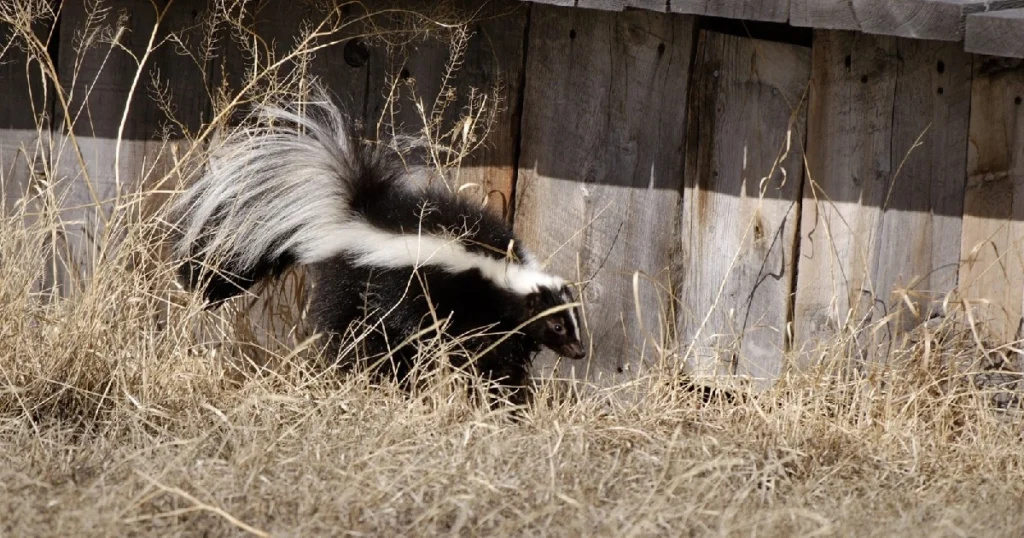
When it comes to trapping skunks, choosing the right trap is crucial. The wrong trap can lead to injury or harm to the skunk and may even be ineffective in catching the animal. This section will discuss the types of traps available and how to place them properly.
When catching these unwanted critters, several traps are available. The most common types are live traps and lethal traps.
Live traps, also known as humane traps, allow you to capture the skunk without harming it. These traps are designed to hold bait inside and keep skunks or raccoons contained until they can be released into the wild. Live traps can be purchased online or at your local hardware store, or you can make your skunk trap using materials such as wire mesh.
Lethal traps are designed to kill the skunk. They must only be used as a last resort, as they can be dangerous and inhumane. You can purchase lethal traps online or at your local hardware store.
Once you have chosen the right trap, it's important to place it properly to increase your chances of catching the skunk. Skunks are nocturnal animals, so it's best to set the trap at night when most active.
When placing the trap, consider the skunk's behavior. Skunks are known for their strong sense of smell, so it is important to place the trap downwind from the skunk's den or feeding area so that the skunk is attracted to the strong odor. You can also use peanut butter or cat food bait to lure the skunk into the trap door.
In addition, it's important to place the trap in a safe and secure location. Ensure the trap is on level ground and cannot be easily tipped over by the skunk or other animals. A covered trap can be more successful. Also, check the trap regularly to ensure the skunk is not trapped for too much time.
You can safely and effectively trap a skunk without harming the animal by choosing the right trap and properly placing it.
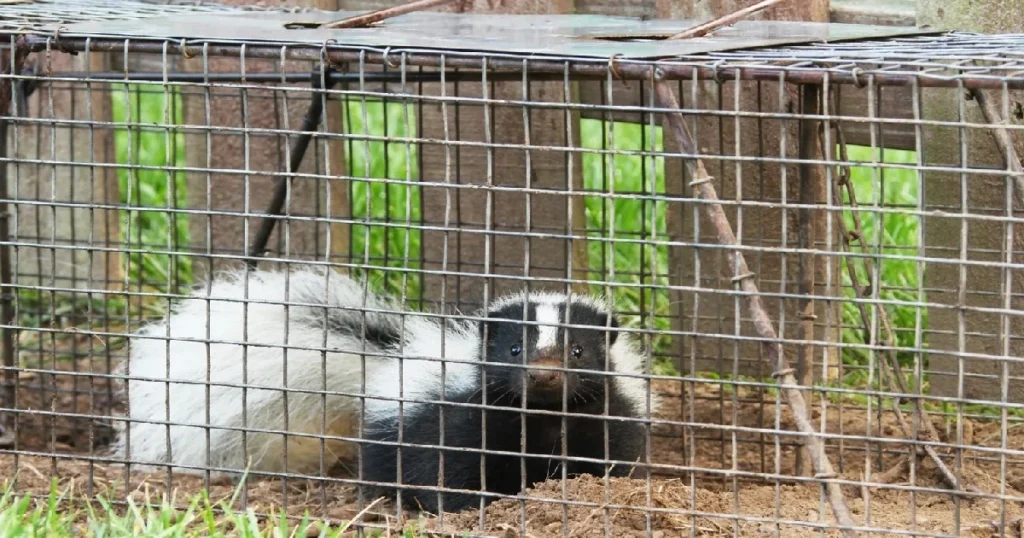
Skunks can be attracted to various baits, but some are more effective than others. Here are some tips on choosing the best bait for your skunk trap.
The best way to trap a skunk is to use a bait that will attract it to the trap. Some of the most effective baits you can use are:
Once you have chosen your bait, placing it in the right location in the trap is important. The bait should be placed at the back of the trap, as far away from the entrance as possible. This will encourage the skunk to enter the trap fully, increasing the chances of a successful capture.
How to trap a skunk under my porch or deck? You may need to lure it out before you can trap it. The best way to do this is to place a small amount of bait outside of the trap, leading up to the entrance. This will encourage the skunk to follow the scent and enter the trap.
Learning how to make a skunk trap is more difficult than buying one. Remembering that skunks are nocturnal animals is important, so it is best to set your trap at night and check it in the morning. This gives you the best chance to catch a skunk.
These baiting strategies can increase your chances of successfully trapping a skunk without getting sprayed. Remember to handle traps carefully and release any trapped skunks far away from your home and other populated areas.
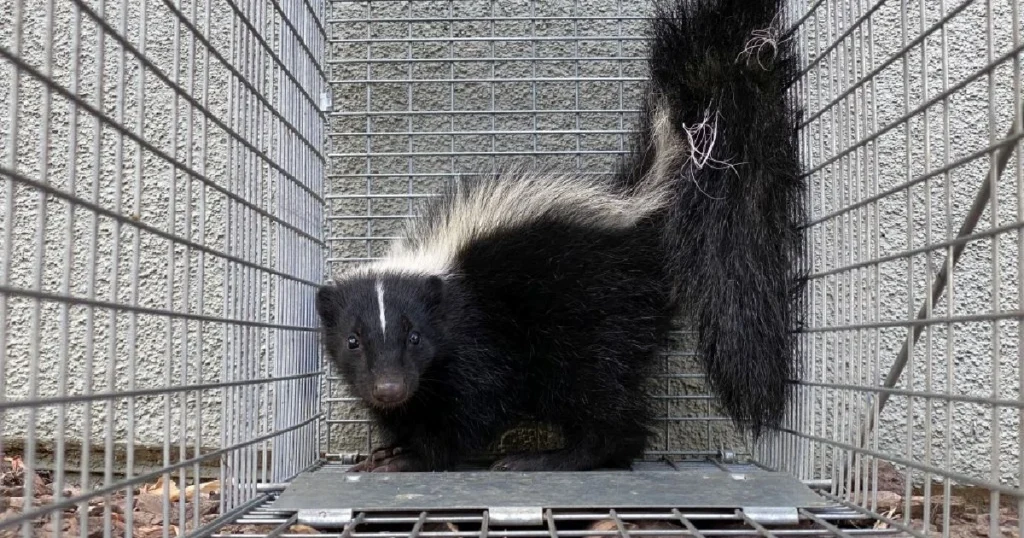
When trapping a skunk, it is important to have the right trap mechanism. Live trap for skunks are the most humane option and are widely available. These traps usually use a spring-loaded door that closes behind the animal once it enters the trap. Choosing a trap that is large enough to fit a skunk comfortably but not so large that the animal can easily escape is important.
Another important factor to consider when selecting a trap mechanism is the material. Steel traps are durable and long-lasting but can be heavy and difficult to transport. On the other hand, traps made from lighter materials like aluminum may be easier to handle but may not be as durable.
Once the trap mechanism has been selected, setting the trap sensitivity correctly is important. This will ensure that the trap will trigger when the skunk enters but not when other animals or objects come near it.
To set the trap sensitivity, adjust the trigger mechanism so that it is activated after a certain amount of pressure. This can be done by adjusting the tension on the trigger or adding weight to the trigger plate.
You must place the trap in the right location. Skunks are attracted to areas with food and shelter, so placing the trap near a den or food source can increase the chances of catching a skunk. However, ensuring the trap is not placed in an area that could harm other animals or people is important.
Correctly selecting the right trap mechanism and setting the sensitivity can increase an individual's chances of catching a skunk in a live trap. Remember always to handle traps carefully and safely and humanely release trapped animals.
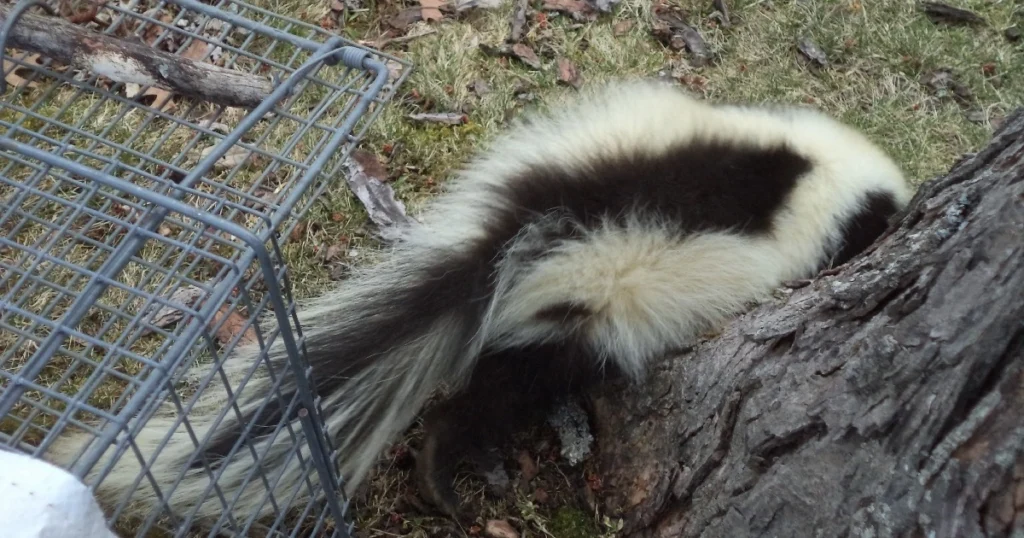
When it comes to trapping skunks, location is key. Skunks are nocturnal creatures, so it's important to place the trap in an area where they are known to frequent at night. This could be near your garbage cans or compost pile or under a porch or deck where they may seek shelter.
It's also important to consider the safety of the skunk and the trapper. The trap should be placed where it won't be disturbed by children or pets and where the skunk won't be in danger of being attacked by other animals.
The best time to trap a skunk is early morning, just before dawn. This is when the skunk is most likely out and about, searching for food. It's important to check the trap frequently throughout the day, as leaving a trapped skunk in the heat can be dangerous for the animal.
It's also important to note that trapping a skunk can take time. Depending on the location and the skunk's behavior, it could take a few days to a few weeks to successfully trap the animal. It's important to be patient and persistent and to check the trap regularly to ensure the skunk is not left trapped for too long.
When trapping a skunk under a porch or house, it's important to block off all other potential exit points to ensure the skunk is forced to enter the trap. This will require creative thinking and problem-solving. You must take the time to do it properly to avoid any potential risks or harm to the skunk or the trapper.
In summary, trapping a skunk requires careful consideration of the location and timing of the trap. Placing the trap in an ideal location and checking it regularly during the best times to trap can increase the chances of success. However, it's necessary to be patient and persistent while taking all necessary precautions to ensure the safety of both the skunk and the trapper.
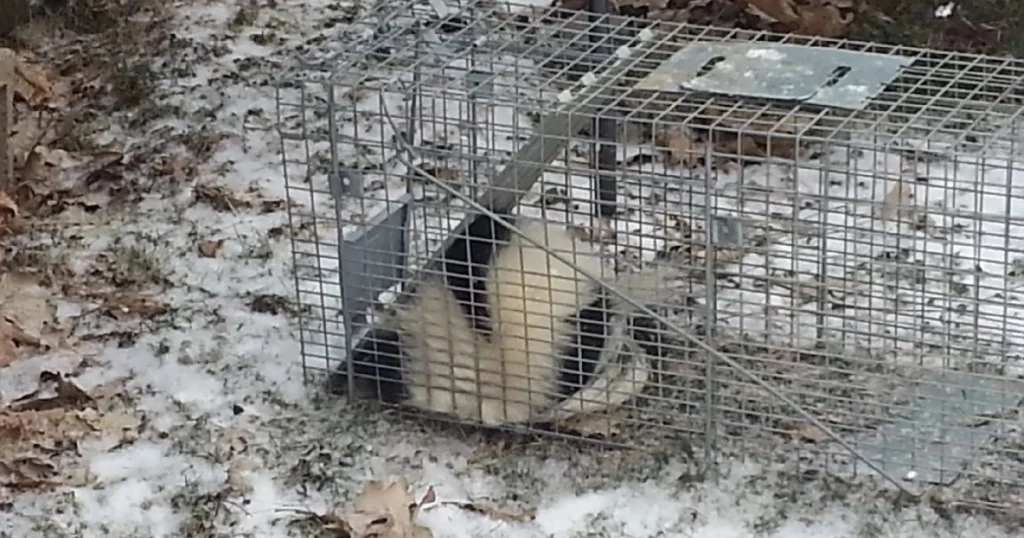
Once the skunk trap has been set up, it is crucial to check it frequently to ensure it is not left in the trap for too long. The following subsections will cover the frequency of checks and humane considerations.
It is recommended that the trap be checked every few hours to ensure that the skunk does not suffer from dehydration or hunger. Leaving the skunk in the trap for an extended period can cause stress and even death. If the trap is set up in a remote location, it is advisable to check it at least once daily.
When checking the trap, it is essential to approach it slowly and quietly to avoid startling the skunk. Skunks are known to spray when they feel threatened, so handling the trap carefully is crucial. Once the skunk is captured, it should be relocated to a safe location, preferably far away from human habitation.
It is important to note that skunks can live for two weeks with no food or water. Therefore, it is crucial to check the trap frequently to ensure that the skunk does not suffer from dehydration or hunger.
In conclusion, checking the trap frequently and handling the skunk carefully is crucial to ensure that the trapping process is humane and effective.
When handling a captured skunk, it’s important to approach cautiously to avoid getting sprayed. Skunks are known for their pungent odor and will spray as a defense mechanism when they feel threatened or scared. Special care should be taken when handling baby skunks as they are more prone to spraying.
Before approaching the skunk, wearing protective gear like gloves, long sleeves, and pants is important. This helps prevent any direct contact with the skunk’s spray.
Approach the trap slowly and quietly, speaking calmly and soothingly. Avoid any sudden movements or loud noises that may startle the skunk.
Once the skunk has been captured, it's important to transport it safely to a new location. This can be done by placing the trap in the back of a truck or car or by carrying the trap by hand.
When you are on your way to release a skunk, it's important to keep the trap covered with a blanket or tarp to prevent the skunk from seeing any movement or feeling threatened. This will help keep the skunk calm and reduce the risk of it spraying.
It's also important to release the skunk in a safe and appropriate location, such as a wooded area away from residential areas. Be sure to release the skunk during daylight hours so it has a chance to survive.
Remember, trapping and handling a skunk can be dangerous and should only be attempted by people with the experience and proper equipment. Always follow local laws and regulations regarding the trapping and relocation of skunks.
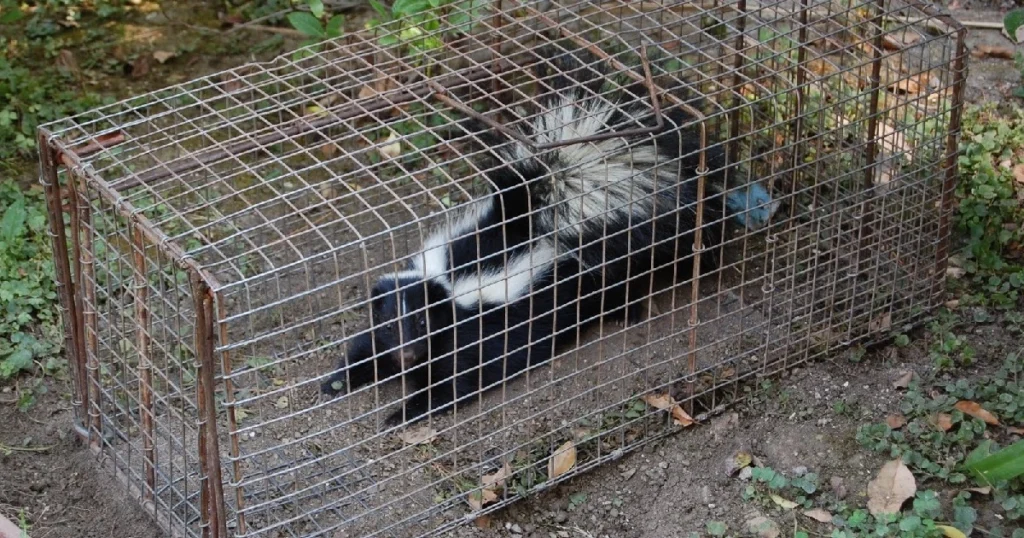
Skunks can be persistent creatures, and it is important to take steps to prevent future intrusions after successfully trapping and removing them from your property. This section will cover two main strategies for preventing skunks from returning: securing the area and deterring skunks.
The most effective way to prevent skunks from returning is to secure the area where they previously accessed your property. This can involve a few steps, such as:
By taking these steps, you can make it much more difficult for skunks to access your property and find a place to nest.
Another strategy for preventing skunks from returning is deterring them from your property. There are some ways to do this, including:
Remember that these deterrents may not work for all skunks, as some may be more persistent than others. However, combining these strategies with proper trapping and removal techniques can greatly reduce the likelihood of future skunk intrusions.
Critter Stop has a fantastic reputation, and customer reviews online because it provides high-quality work and great customer service. For a free inspection to solve your problem with wildlife or pest removal from your property, call Critter Stop at (214) 234-2616.
Trapping skunks is regulated by wildlife laws in most states. Before attempting to trap a skunk, you must check with local wildlife authorities to ensure that trapping is legal in your area. In some states, trapping skunks may require a permit or special license. Failure to comply with wildlife regulations can result in fines or other legal consequences.
It is important to note that relocating skunks may not be legal in all areas. Some states prohibit the relocation of skunks, while others have specific guidelines for relocation. Relocating skunks to areas where they are not native can also negatively affect local ecosystems.
Ethical considerations must also be considered when trapping skunks. Skunks are wild animals that may become stressed or injured during trapping. It is important to minimize the time the skunk spends in the trap and release it as quickly as possible once it has been caught.
In addition, it is important to consider the safety of the trapper and the skunk. Skunks are known for spraying a foul-smelling liquid as a defense mechanism. Trappers should wear protective clothing and take other precautions to avoid being sprayed.
Overall, it is important to approach skunk live trapping with caution and respect for wildlife regulations and ethical considerations.
To trap a skunk, one needs to set up a trap where the skunk is known to frequent. The trap should be baited with food attractive to skunks and placed where the skunk is likely to encounter it. Once the skunk is trapped, it can be safely removed from the area.
The best way to catch a skunk is to use a live trap specifically designed for this purpose. These traps prevent the skunk from spraying and can be easily transported once the skunk is captured.
To trap a skunk without getting sprayed, it is important to use a trap specifically designed for capturing skunks. These traps are designed to prevent the skunk from spraying and can be easily transported once captured. Additionally, it is important to approach the trap slowly and quietly to avoid startling the skunk.
To catch a skunk in a live trap, one needs to set up the trap in the area where the skunk is known to frequent. The trap should be baited with food attractive to skunks and placed where the skunk is likely to encounter it. Once the skunk is trapped, it can be safely removed from the area.
The length of time it takes to trap a skunk can vary depending on the skunk's behavior and the effectiveness of the trap. Sometimes, a skunk may be trapped within a few hours, while it may take several days in other cases.
To trap a skunk under a porch, one needs to set up a trap in the area where the skunk is known to frequent. The trap should be baited with food attractive to skunks and placed where the skunk will likely encounter it. Once the skunk is trapped, it can be safely removed from the area.
Skunks should not be trapped for an extended period, as this can cause stress and potentially harm them. The trap should be checked regularly, and the skunk should be released as soon as possible after capture.
Peanut butter, canned cat food, dry cat food, and fish are attractive to skunks. However, it is important to avoid foods that may be harmful to skunks, such as chocolate or foods high in salt or sugar.
An effective skunk trap should be specifically designed to capture skunks and include features that prevent them from spraying. Additionally, the trap should be easy to transport and made of durable materials.
Constructing a skunk trap at home is not recommended, as it can be dangerous for both the skunk and the person constructing the trap. It is recommended that you purchase a trap that is specifically designed for capturing skunks.
Peanut butter, canned cat food, and fish are the most effective bait for capturing skunks. However, it is important to avoid using foods that may be harmful to skunks, such as chocolate or foods high in salt or sugar.
It is important to use a trap specifically designed for capturing skunks to prevent them from spraying. Extra caution is needed when dealing with baby skunks as they are more likely to spray prematurely. Once captured, these traps can be easily transported.
Humane ways to encourage a skunk to vacate an area include making it less attractive to skunks with noise and light and using repellents specifically designed for skunks. Additionally, removing food sources that may attract skunks to the area is important. While tomato juice is often suggested as a remedy for skunk odor, it is ineffective in neutralizing the smell.
Visit our Critter Library and learn more about our furry friends